The Vietnamese Jesus statue was erected in 1993, in one of the least religious countries in the world. According to the last official statistics (from 2018), only 7,4 % of Vietnamese people consider themselves Catholics! Still, among the strong traditions of Buddhism and Vietnamese folk religion, the Christian minority pulled the incredible stunt. After 20 years of building and constructing, the enormous concrete Son of God appeared on the southern cape of the peninsula that gave it a name – the Christ of Vung Tau.
If you like XXL religious adoration, you will love the largest Vishnu statue in Bali, Indonesia!
No samba for Vietnamese Jesus
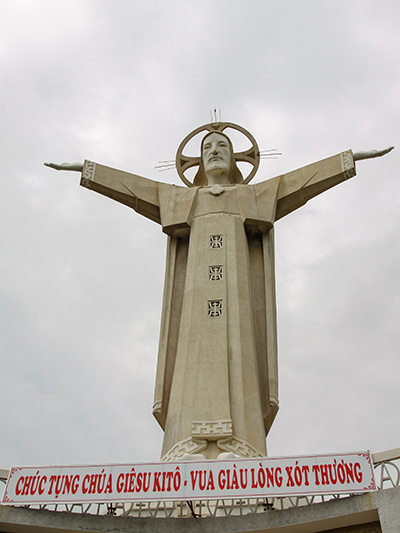
Built more than six decades after the Christ the Redeemer in Rio de Janeiro, Brazil, the Vietnamese Jesus statue, known as Christ the King, never gained the same touristic momentum.
Stretching his arms over Mount Nho (Small Mountain, 170 meters high) and gazing into the distance of the South China Sea, it might not have the same grandiose aura as the South American iconic monument looking over the colorful Brazilian metropolis from the 700 meters high Corcovado mountain. But that doesn’t make the Vietnamese Jesus a no-trump racehorse!
OK, on the streets of Vung Tau you might not see barely dressed Vietnamese ladies shaking their bottoms and feather headpieces like tomorrow doesn’t exist.
On the streets of Vung Tau, you won’t see kids skipping school classes to play street football while dreaming of becoming the next Neymar.
Vung Tau people appreciate pho over moqueca, and would never trade rice wine for cachaça.
Vietnam and Brazil might be very similar and very different. But when comparing their religious monuments, the Vietnamese Jesus statue is the clear winner
The two countries might argue which one loves fresh coconut better, or whose coffee wins the race, but when speaking about oversized Biblical monuments, the Asian Jesus statue clearly deserves his crown!
With 32 meters in height (2 meters more than the Redeemer), the Christ of Vung Tau might only seem smaller, as his pedestal is just 4 meters high.
However, the Vietnamese Jesus statue provides a very particular benefit – one can climb into it and admire the views of the town and the whole coastline from Christ’s perspective.
You won’t get these divine views even at the base of the statue, due to the overgrown trees. But Jesus sees it all!
The trick is only that you need to climb the mountain and Christ’s interior yourself, there is no cable car you can pay to do the physical work for you!
In the Philippines, Jesus is celebrated in a more radical way. Check it out here, if you're not faint-hearted!
Christ of Vung Tau: A small step for a pilgrim, a giant Jesus statue for mankind
Available data disagree on how many steps you need to climb to get to the monument’s platform. Some say there are 1000 steps, some exaggerate with even 1200, but the closest guess would be 800-ish.
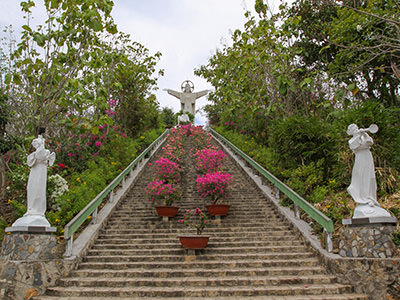
I haven’t counted them myself, but I am certain the numbers stopped being presented after the 800 mark.
From my point of view, the obstacle is not the number of steps, but their relative shallowness. As a 185-centimeters-tall guy, I felt that the steps, sometimes just 10 centimeters high, are more tiring than the steps you would normally find in the buildings of Western civilization.
The pro-Asian-foot design gave me the feeling that I am always lifting my legs but not achieving much. And that’s what felt tiring!
Some Westerners would disagree with me. They think more small steps are less tiring than less of normal-size ones. Well, you be the judge!
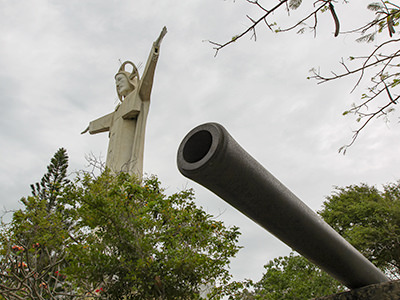
In any case, rest stops are provided along the way. As this is a religious site, one might use the stops to pray, and I guess Biblical statues, chubby angels, apostles, and pietas could be inspiring for that call.
Otherwise, just take a moment to breathe in, admire the fake deer drinking from the artificial lakes, enjoy the floral gardens and bonsai trees, or just rhetorically ask yourself why the chickens are caged.
Speaking of chicken, you might find it intriguing that one of them got materialized as a gigantic building in the jungle of Java. The Indonesian Chicken Church is one of a kind!
Christ of Vung Tau, only for decently (un)dressed
The Vietnamese Jesus statue is well hidden behind the hill’s topography and trees growing on its slopes.
Its whiteness will reveal to you only at the last set of steps (this is the set when you forget to count the stairs and start to take selfies with outstretched arms, like so many before you).
Admission to the statue is free, but beware, if not properly dressed, you might need to do some unplanned T-shirt shopping at the hilltop.
Inside the monument, sleeveless shirts and tops, short pants and miniskirts, but also shoes, hats, and bags are prohibited.
Omnipresent warnings about pickpockets operating in the area make you think twice about whether you should leave your valuables at the entrance of the statue.
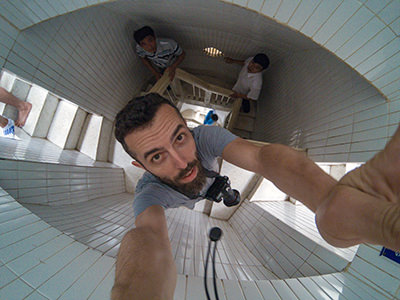
I have visited Vung Tau on Monday, so the monument area did not seem as crowded as it might get on the weekends. The day was cloudy enough that I didn’t mind climbing the hill at noon.
If you want to take a picture of the Vietnamese Jesus without random strangers protruding their heads through his shoulders, the lunch break between 11:30 and 13:30, when Christ of Vung Tau closes to visitors, is truly your safest bet!
Also, the tourists don’t crowd it at 13:30 exactly, so this is the moment you could get lucky enough to not have to wait in the queue for the balconies on Christ’s shoulders.
The staircase where you’ll need to wait is narrow. And the balcony is maybe an oversized word – let’s just say that on the top of the 133-step spiral marble staircase inside of the statue two hollows let you squeeze out to get that nice sea breeze. Two, maybe three friendly strangers can fit in at one time.
Searching for a place to stay near the Christ of Vung Tau monument? Find the best accommodation offers here!
Vietnamese Jesus has rules for you!
Besides expected signs for no smoking and no littering, they will also advise you that running, loud speaking, writing or drawing on the wall, consuming food and drinks, and spitting are forbidden.
Also, “no getting drunk and vomiting”. Maybe you could pass with just being drunk or just vomiting, not sure.
For the rules for which they couldn’t find an adequate pictogram, the full sentence is provided. Here’s an example: “Do not show unworthy and profane acts between couples in this sacred place.”
Then again, I think even the solo profane acts would not be that welcomed! It makes you wonder how did they come up with this being a potential issue.
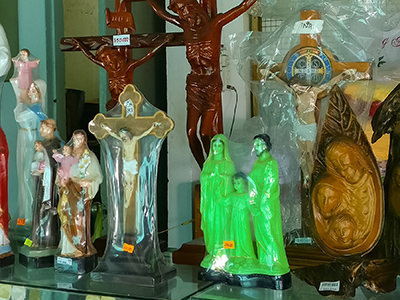
When leaving the mountain, do drop by the souvenir shop!
You can have your own miniature Vietnamese Jesus for already 10.000 Dongs (40 Cents!).
The price grows with the size of the Christ, and some of them come in phosphorescent form, which means they glow in the dark!
For 240.000 Dongs (10 Euros) you could get the whole Holy Family that will enlighten your room in green.
If they pulled it off in Međugorje with the Madonna miraculously glowing in the dark, just think what kind of profitable investment the whole glowing family could be!
Did you like the Christ of Vung Tau?
Pin it for later!
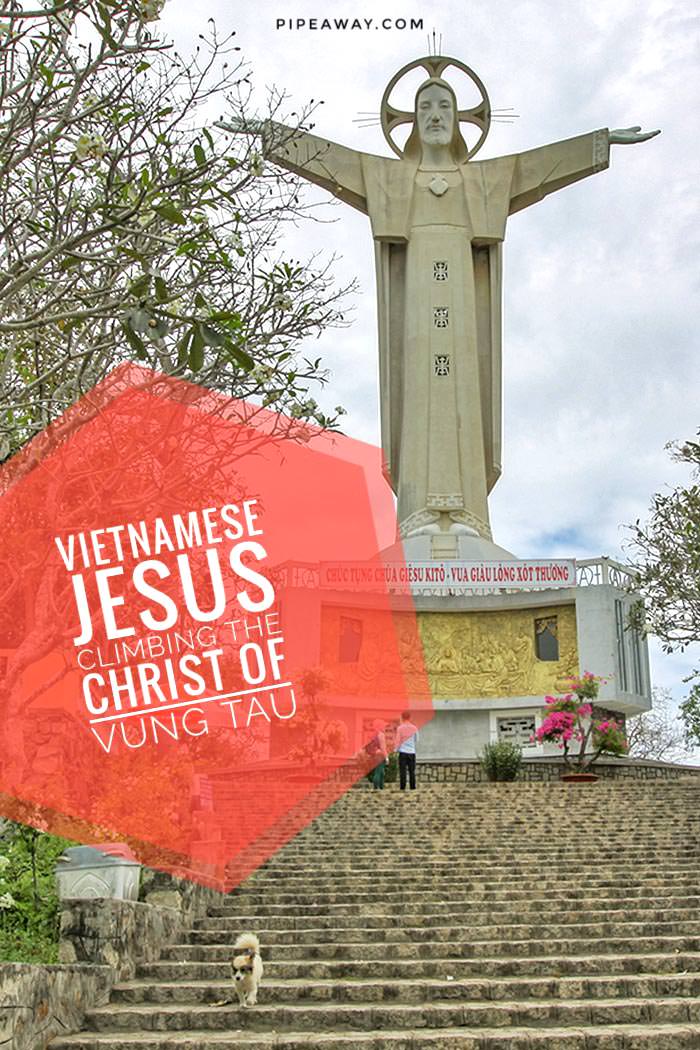
Disclosure: This post may contain affiliate links, which means if you click on them and make a purchase, Pipeaway might make a small commission, at no additional cost to you. Thank you for supporting our work! This post was originally published on April 17th, 2017, and was updated on March 31st, 2022.

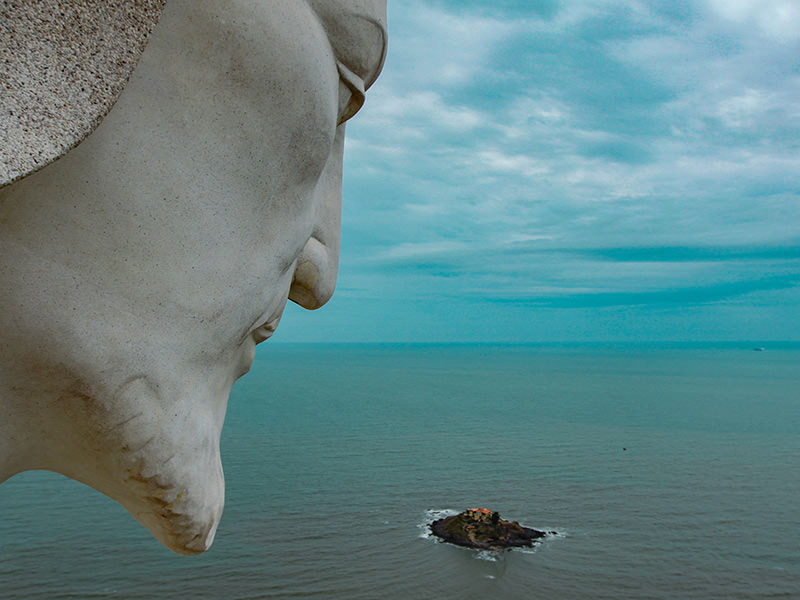

Do your homework Ivan. Catholicism has play a significant role in Vietnam since arriving over 500 years ago. They built hospitals, schools and many other social welfare agencies that persist today. One of their missionaries produced the foundations of what has become the current Vietnamese language. Catholics also have been subjected to persecutions every bit on par with the Muslims in Burma today. The last was from the communists since 1975. Almost 700,00 boat people were boat people. Today Catholics Vietnamese are largely very educated and productive. They are very important to the Vietnamese economy and society through their contribution to health, education and social welfare. They are a dynamic minority who do not need to perform stunts to demonstrate their faith.
Lift your game Ivan – there is a large plank in both of your eyes.
Dear Paul!
I haven’t been writing at all about the “level of faith” of the Catholics in Vietnam, or about the lack of their contribution to the Vietnamese society.
But there, you did. I hope that helps your feeling of self-fulfillment.
What I did write about is that there is a very large monument of Christ in a country where Catholics are a tiny minority (even you call them a minority, so I guess we cannot disagree on world statistics).
If I was doing anything with this article, I was promoting this monument, that many people in the world did not even hear about!
Building such a large Jesus statue IS a stunt/feat/accomplishment. It would be the stunt even in the country with a Catholic majority. There is no reason that the word “stunt” should be treated as offensive. It is an impressive accomplishment.
The metaphor with a plank – it was me who felt that the Judgement Day has arrived after reading your comment.
Thanks for fighting for Catholicism in such a passionate way! Sometimes, that is just a lame excuse for unreasonable attacks, the history is full of those examples as well. Your arguments would resonate better if formed in a constructive phrasing.
Good luck!
Thanks Ivan. Many places for tourists in Vietnam are closed on Mondays, so your comment about going to the Jesus statue on a Monday was very helpful (today is Monday and we’re on our way)!
Oh, I am glad the article was helpful!
Do let me know how did you find your visit! Did you enjoy it?
Koks geras straipsnis!
Labai ačiu 🙂
seems over 1000 steps it’s a killer going up ok with places to stop and rest get some more water going down is hard on the legs but well worth it
Every effort rewards, and no success comes without the price 😉
Where’s the trail/stairs head?
Not sure if your question is rhetorical, spiritual, or something else?
Stairs lead to the monument of Jesus Christ, the topic of this article 😉
Nice write-up, Ivan. And yes, I do agree with you that this statue is an amazingly massive feat for the small percentage of Vietnamese Catholics. I am from a country with a Catholic majority (or to be more factual, wih a large Catholic influence over the country and its population) and we do not have such a grand statue. But, I do not know if you have heard about this, there is a current project by the SVD to construct a 160-foot tall statue of Jesus in the province of Pampanga, right in my hometown of Porac. It already had its ceremonial/official groudbreaking a few months back.
My search for a list of do’s and don’ts in visiting this statue brought me here. I hope it wouldn’t be too much of a bother if I ask some questions since I want to climb those hundreds of steps. 🙂
*If no drinks are allowed inside the statue, then why are there so many tips I have read to “bring/drink water”?
*No shoes – can we go up wearing socks? I do not think I can do barefoot.
*No bags – do they have any provisions by the entrance, like rental lockers, in which visitors can safely leave their bags and shoes?
Will truly appreciate if you can clarify these things for me so I would know what to do when I visit. 🙂
Thanks for your feedback, Kitty!
No, I haven’t heard about the Pampanga statue project, but I’m sure that another Asian Jesus statue will be a reason more to visit your part of the Philippines.
By the way, when I visited Pampanga myself during Easter, it truly impressed me, as you can read in this article: https://www.pipeaway.com/maleldo-festival-cutud-pampanga-crucifixion-holy-week/
I hope to go back again!
Here are my answers to your questions on the Vietnamese Jesus:
1. If you have read the tips on bringing water along, I would assume that’s because there are many stairs to climb before even entering the statue. So taking a sip outside could rehydrate you for the final climb.
2. Yes, you can enter in socks, no worries. If you carefully watch my Youtube video, you’ll see I have my socks on 😉
3. Sadly, no, there were no lockers by the entrance. Just a pile of everyone’s shoes and bags together. I was constantly aware of that fact while inside, as it does remind you that someone could steal your belongings. I’d recommend not bringing valuables you cannot put in your pockets to ensure you won’t lose them.
There, hopefully, this helped. Enjoy your Jesus statue visit!
Thank you for those clarifications, Ivan. I really wish I could fit that in my itinerary because my travel companion dislikes a lengthy road travel. XD
Yes, I have read your Maleldo article and I have commented there too. 🙂
Years down the road, we will see if that gigantic Jesus statue in my part of the world will really be built. Maybe you could visit it too then. If you would, I hope we could both remember this brief communication and I could assist you in your visit. 🙂
That would be lovely!
Please keep me updated when Jesus arises 😉